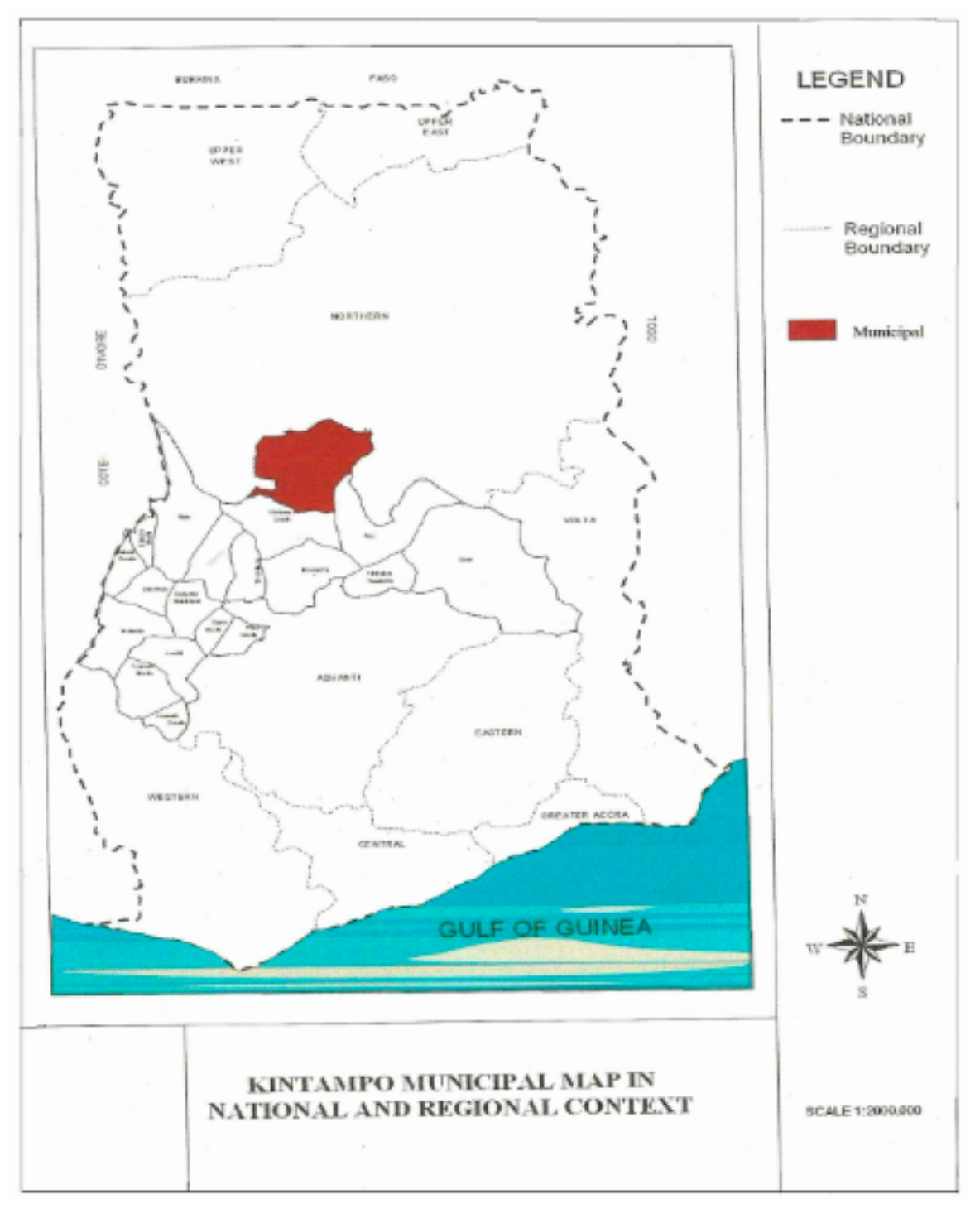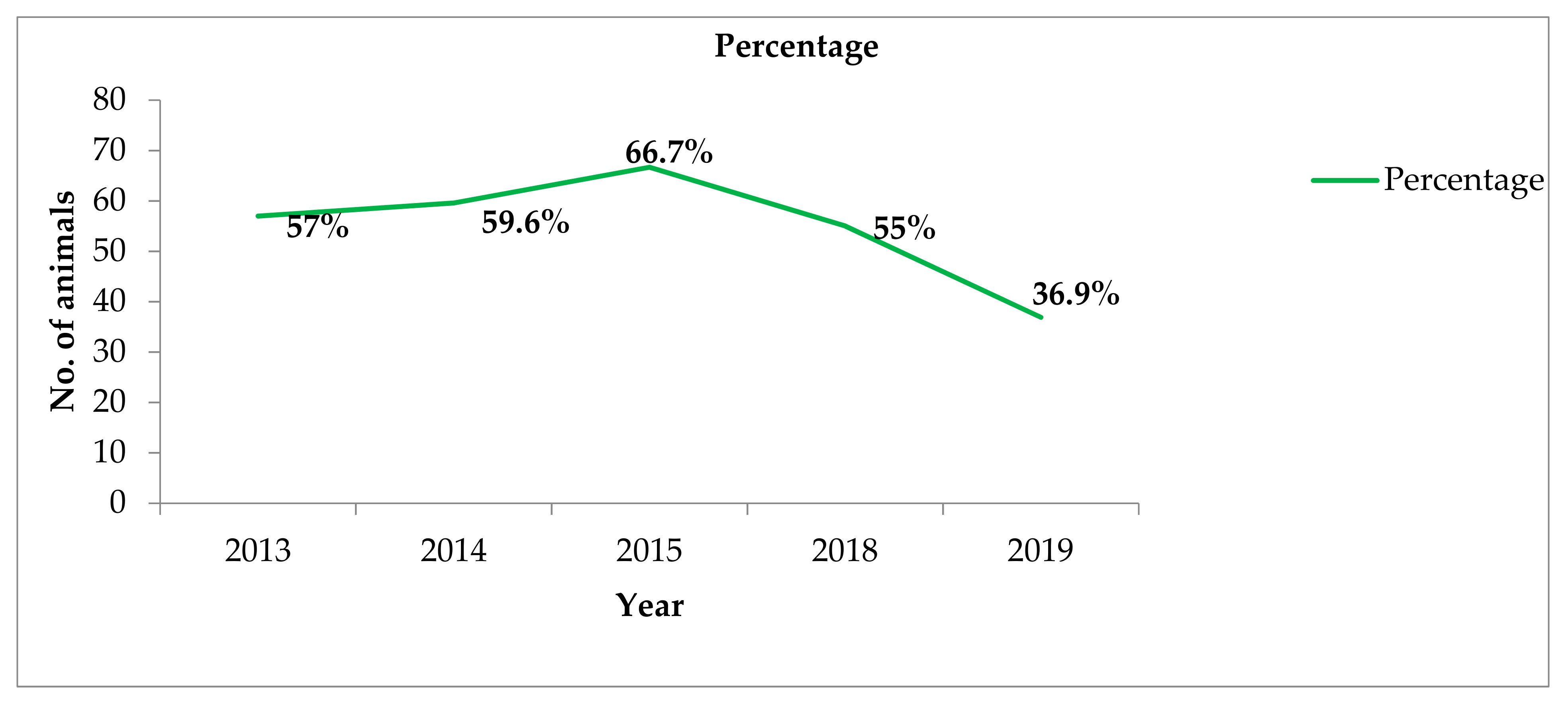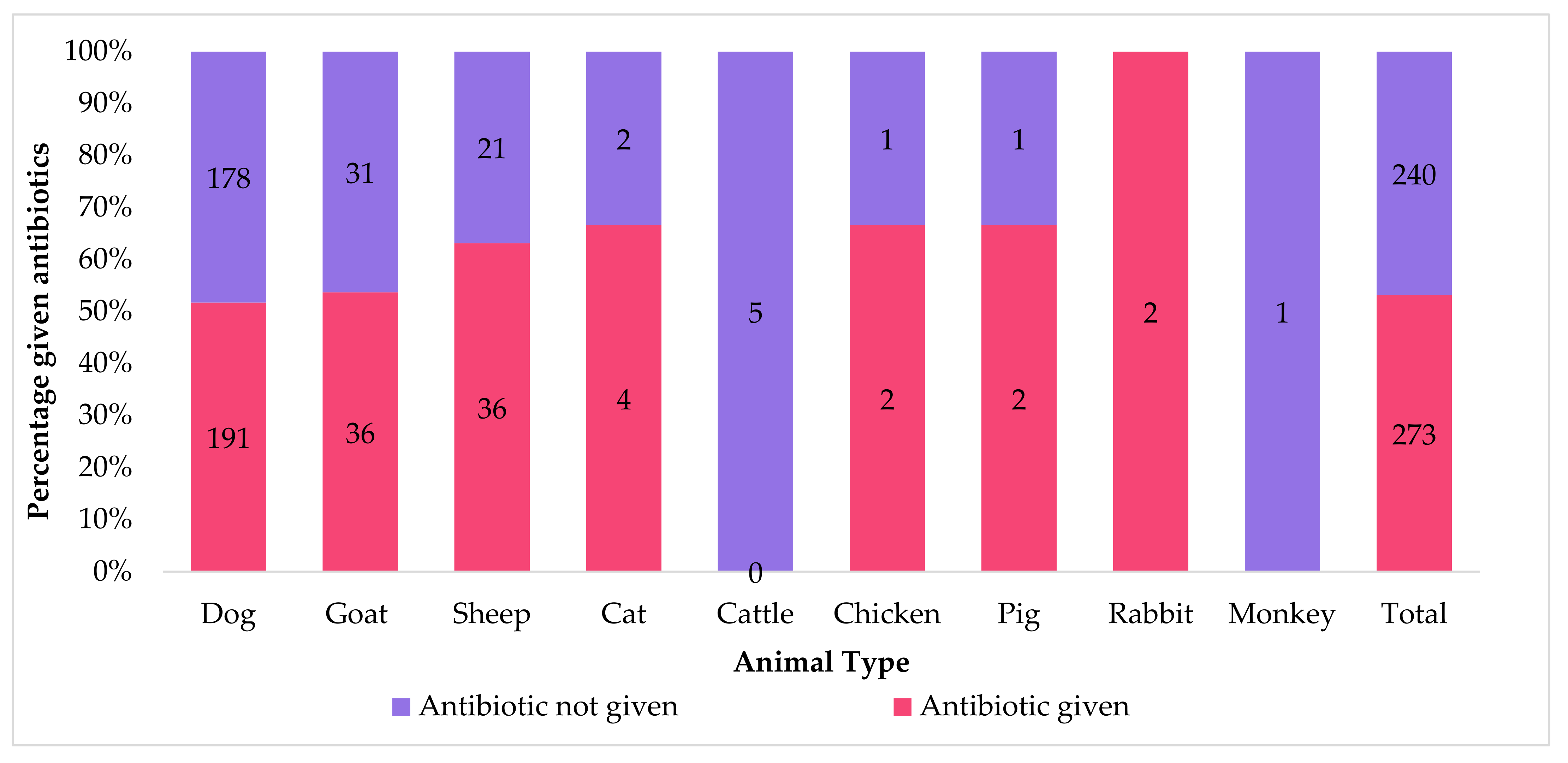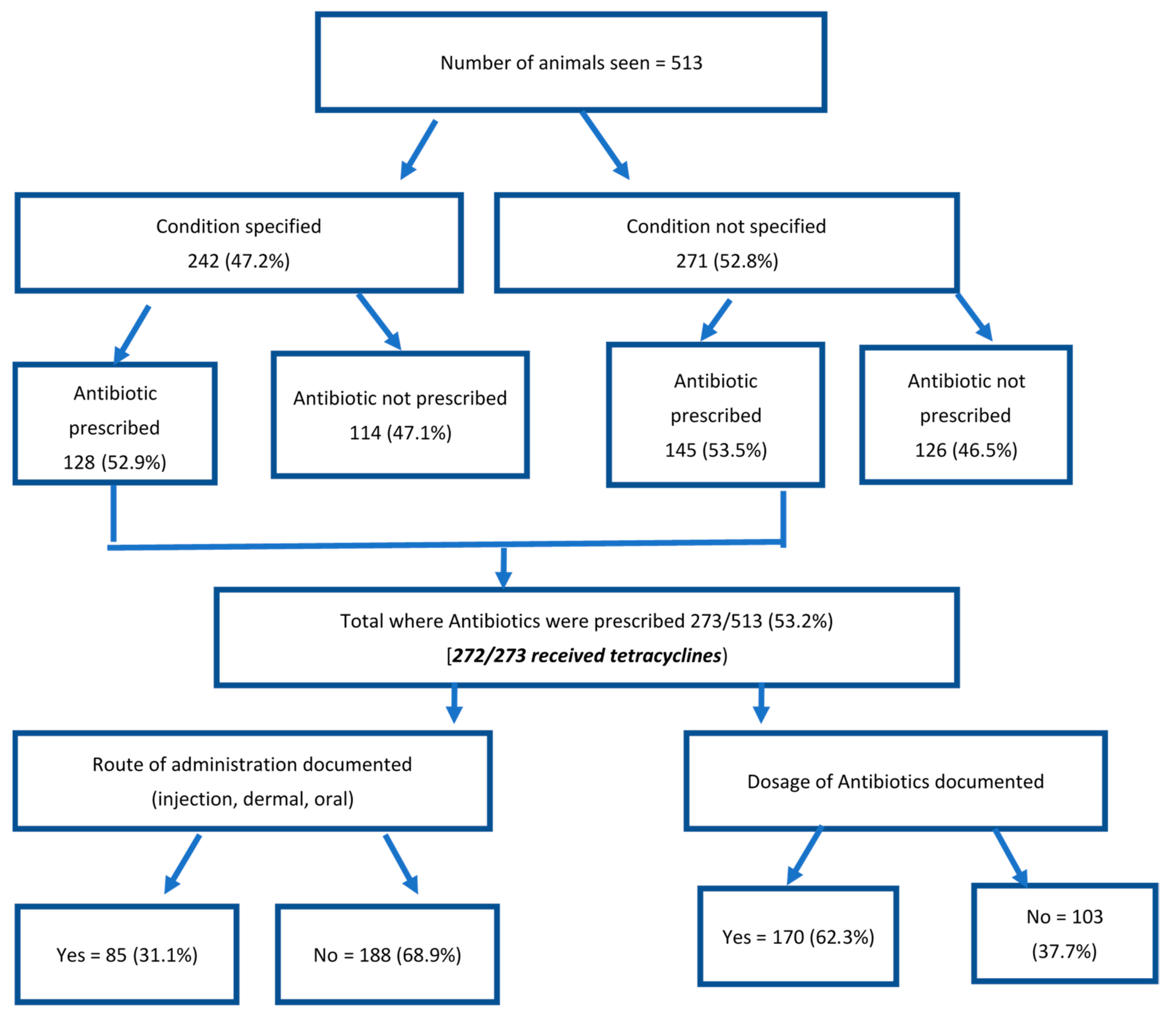Antibiotic Use in a Municipal Veterinary Clinic in Ghana
Abstract
:1. Introduction
2. Materials and Methods
2.1. Study Design
2.2. Study Setting
2.2.1. General Setting
2.2.2. Specific Setting
2.3. Study Population
2.4. Data Variables and Sources of Data
2.5. Data Entry and Analysis
3. Results
3.1. The Number and Proportion of Animals Receiving Veterinary Care by Type of Animals
3.2. The Number and Proportion of Animals Receiving Antibiotics by Type of Animal and Year
3.3. The Documentation of Condition, Antibiotics Prescribed, Dosage, and Route of Administration
4. Discussion
5. Conclusions
Author Contributions
Funding
Institutional Review Board Statement
Informed Consent Statement
Data Availability Statement
Acknowledgments
Conflicts of Interest
References
- Adesokan, H.K.; Akanbi, I.O.; Akanbi, I.M.; Obaweda, R.A. Pattern of antimicrobial usage in livestock animals in South-Western Nigeria: The need for alternative plans. Onderstepoort J. Vet. Res. 2015, 82, 1–6. [Google Scholar] [CrossRef] [PubMed]
- Afari-Asiedu, S.; Kinsman, J.; Boamah-Kaali, E.; Abdulai, M.A.; Gyapong, M.; Sankoh, O.; Hulscher, M.; Asante, K.P.; Wertheim, H. To sell or not to sell; the differences between regulatory and community demands regarding access to antibiotics in rural Ghana. J. Pharm. Policy Pract. 2018, 11, 30. [Google Scholar] [CrossRef] [PubMed] [Green Version]
- Tang, K.L.; Caffrey, N.P.; Nóbrega, D.; Cork, S.C.; Ronksley, P.E.; Barkema, H.; Polachek, A.J.; Ganshorn, H.; Sharma, N.; Kellner, J.; et al. Restricting the use of antibiotics in food-producing animals and its associations with antibiotic resistance in food-producing animals and human beings: A systematic review and meta-analysis. Lancet Planet. Health 2017, 1, e316–e327. [Google Scholar] [CrossRef]
- Andreoletti, O.; Budka, H.; Buncic, S.; Colin, P.; Collins, J.D.; De, A.; Koeijer, J.G.; Havelaar, A.; Hope, J.; Klein, G.; et al. Foodborne Antimicrobial Resistance as a Biological Hazard. Scientific Opinion of the Panel on Biological Hazards; EFSA: Parma, Italy, 2008; pp. 1–87. [Google Scholar] [CrossRef]
- Boamah, V.E.; Agyare, C.; Odoi, H.; Dalsgaard, A. Antibiotic Practices and Factors Influencing the Use of Antibiotics in Selected Poultry Farms in Ghana. J. Antimicrob. Agents 2016, 2. [Google Scholar] [CrossRef]
- Klein, E.Y.; Tseng, K.K.; Pant, S.; Laxminarayan, R. Tracking global trends in the effectiveness of antibiotic therapy using the Drug Resistance Index. BMJ Glob. Health 2019, 4, e001315. [Google Scholar] [CrossRef] [PubMed]
- Akpan, M.R.; Isemin, N.U.; Udoh, A.E.; Ashiru-Oredope, D. Implementation of antimicrobial stewardship programmes in African countries: A systematic literature review. J. Glob. Antimicrob. Resist. 2020, 22, 317–324. [Google Scholar] [CrossRef] [PubMed]
- Beyene, T.; Assefa, S.; Ayana, D.; Jibat, T.; Tadesse, F.; Beyi, D.N.A.A.F. Assessment of Rational Veterinary Drugs Use in Livestock at Adama District Veterinary Clinic, Central Ethiopia. J. Vet. Sci. Technol. 2015, 7. [Google Scholar] [CrossRef] [Green Version]
- Dehaumont, P. OIE international standards on antimicrobial resistance. J. Vet. Med. Ser. B Infect. Dis. Vet. Public Health 2004, 51, 411–414. [Google Scholar] [CrossRef] [PubMed]
- Schar, D.; Sommanustweechai, A.; Laxminarayan, R.; Tangcharoensathien, V. Surveillance of antimicrobial consumption in animal production sectors of low- and middle-income countries: Optimizing use and addressing antimicrobial resistance. PLoS Med. 2018, 15, e1002521. [Google Scholar] [CrossRef] [PubMed] [Green Version]
- Ministry of Health, Standard Treatment Guidelines 5th edition—Ghana; Ghana National Drugs Programme (GNDP): Accra, Ghana, 2004.
- Yevutsey, S.K.; Buabeng, K.O.; Aikins, M.; Anto, B.P.; Biritwum, R.B.; Frimodt-Møller, N.; Gyansa-Lutterodt, M. Situational analysis of antibiotic use and resistance in Ghana: Policy and regulation. BMC Public Health 2017, 17, 896. [Google Scholar] [CrossRef] [PubMed] [Green Version]
- Kamwanja, L.A.; Sake, J.; Awotedu, A.; Fute, I.; Ndomondo-Sigonda, M. Situation Analysis Study on Medicines Registration Harmonisationin Africa, Final Report for the Economic Community of West African States; African Union Development Agency (AUDA-NEPAD): Midrand, South Africa, 2011. [Google Scholar]
- Ministry of Health, Republic of Ghana Policy on Antimicrobial Use and Resistance, 1st ed.; Pharmaceutical Services, Ministry of Health: Accra, Ghana, 2017.
- Ministry of Food and Agriculture-Ghana. Livestock Development in Ghana Policies and Strategies; Ministry of Food and Agriculture: Accra, Ghana, 2004; pp. 1–122. [Google Scholar]
- Ministry of Food and Agriculture-Ghana. Kintampo North Municipal. 2020. Available online: https://mofa.gov.gh/site/sports/district-directorates/brong-ahafo-region/176-kintampo-north-municipal (accessed on 5 March 2021).
- Mockshell, J.; Ilukor, J.; Birner, R. Providing animal health services to the poor in Northern Ghana: Rethinking the role of community animal health workers? Trop. Anim. Health Prod. 2014, 46, 475–480. [Google Scholar] [CrossRef] [PubMed]
- Lalonde, A.-M.; Hoenig, D.; Wambui, C. Veterinary Legislation Support Programme GHANA; Oie-Pvs; World Organisation for Animal Health 12: Paris, France, 2017. [Google Scholar]
- Graphic online VN. Accelerating the Implementation of the ECOWAS Veterinary Pharmacy Protocol in Ghana. 2020. Available online: https://www.graphic.com.gh/business/business-news/accelerating-the-implementation-of-the-ecowas-veterinary-pharmacy-protocol-in-ghana.html (accessed on 11 March 2021).
- Kintampo Health Research Centre. KHRC. Kintampo Health and Demographic Surveillance System. 2020. Available online: https://kintampo-hrc.org/kintampo-hdss (accessed on 5 March 2021).
- Manishimwe, R.; Nishimwe, K.; Ojok, L. Assessment of antibiotic use in farm animals in Rwanda. Trop. Anim. Health Prod. 2017, 49, 1101–1106. [Google Scholar] [CrossRef] [PubMed]
- Ministry of Health & Family Welfare Government of India. National Treatment Guidelines for Antimicrobial Use in Infectious Diseases. 2016. Available online: http://www.ncdc.gov.in/writereaddata/linkimages/AMR_guideline7001495889.pdf (accessed on 8 April 2021).
- Malaysia Ministry of Health. Officially Launched on 26; Pharmaceutical Services Programme Ministry of Health: Putrajaya, Malaysia, 2019. [Google Scholar]
- Republic of Ghana National Drug Policy, 2nd ed.; Ministry of Health (GNDP) Ghana: Accra, Ghana, 2004.
- OIE (World Organization for Animal Health). List of Antimicrobials; Response; Ministry of Health (GNDP) Ghana: Accra, Ghana, 2007; pp. 1–9. [Google Scholar]
- Afari-Asiedu, S.; Oppong, F.B.; Tostmann, A.; Ali Abdulai, M.; Boamah-Kaali, E.; Gyaase, S.; Agyei, O.; Kinsman, J.; Hulscher, M.; Wertheim, H.F.L.; et al. Determinants of Inappropriate Antibiotics Use in Rural Central Ghana Using a Mixed Methods Approach. Front. Public Health 2020, 8, 90. [Google Scholar] [CrossRef] [PubMed] [Green Version]
- OIE. OIE International Standards on Antimicrobial Resistance; OIE publications: Paris, France, 2003. [Google Scholar]
- Aidara-Kane, A.; Angulo, F.J.; Conly, J.M.; Minato, Y.; Silbergeld, E.K.; McEwen, S.A.; Collignon, P.J.; for the WHO Guideline Development Group. World Health Organization (WHO) guidelines on use of medically important antimicrobials in food-producing animals. Antimicrob. Resist. Infect. Control. 2018, 7, 7. [Google Scholar] [CrossRef] [PubMed] [Green Version]
- World Health Organization. WHO List of Critically Important Antimicrobials for Human Medicine (WHO CIA List), 6th Rev. 2017. Available online: http://who.int/foodsafety/publications/antimicrobials-fifth/en/ (accessed on 28 February 2021).
- Norsuzila, Y.; Mardina, A.; Mahamod, I.; Medina, M.; Talarico, T.L.; Casas, I.A.; Chung, T.C.; Dobrogosz, W.J.; Meseko, C.; Makanju, O.; et al. Veterinary Pharmaceuticals and Antimicrobial Resistance in Developing Countries. Intech 1989, 32, 137–144. Available online: http://www.intechopen.com/books/trends-in-telecommunications-technologies/gps-total-electron-content-tec-prediction-at-ionosphere-layer-over-the-equatorial-region%0AInTec (accessed on 11 March 2021).
- Newman, M.J.; Frimpong, E.; Donkor, E.S.; Opintan, J.A.; Asamoah-Adu, A. Resistance to antimicrobial drugs in Ghana. Infect. Drug Resist. 2011, 4, 215–220. [Google Scholar] [PubMed] [Green Version]
- Jessen, L.R.; Sørensen, T.M.; Lilja, Z.L.; Kristensen, M.; Hald, T.; Damborg, P. Cross-sectional survey on the use and impact of the Danish national antibiotic use guidelines for companion animal practice. Acta Vet. Scand. 2017, 59, 81. [Google Scholar] [CrossRef] [PubMed] [Green Version]
- Søndergaard, S.F.; Lorentzen, V.; Sørensen, E.E.; Frederiksen, K. The documentation practice of perioperative nurses. A literature review. J. Clin. Nurs. 2017, 26, 1757–1769. [Google Scholar] [CrossRef] [PubMed]
- Landers, T.F.; Cohen, B.; Wittum, T.E.; Larson, E.L. A Review of Antibiotic Use in Food Animals: Perspective, Policy, and Potential. Public Health Rep. 2012, 127, 4–22. [Google Scholar] [CrossRef] [PubMed] [Green Version]
- Van Boeckel, T.P.; Pires, J.; Silvester, R.; Zhao, C.; Song, J.; Criscuolo, N.G.; Gilbert, M.; Bonhoeffer, S.; Laxminarayan, R. Global trends in antimicrobial resistance in animals in low- And middle-income countries. Science 2019, 365. [Google Scholar] [CrossRef] [PubMed] [Green Version]
- Regulations, V.S. Veterinary Clinical Record Keeping Guidelines; American Association for the Advancement of Science: Washington, DC, USA, 2018; pp. 1–3. [Google Scholar]
- Jeffrey, L.; Roth, J. General Recordkeeping in Veterinary Practice. Alabama Veterinary Medical Association. 2017. Available online: https://www.alvma.com/page/GeneralRecordkeeping (accessed on 8 April 2021).




| Type of Animal | 2013 | 2014 | 2015 | 2018 | 2019 | Total | ||||||
|---|---|---|---|---|---|---|---|---|---|---|---|---|
| n | (%) | n | (%) | N | (%) | n | (%) | n | (%) | n | (%) | |
| Dog | 96 | (71.1) | 76 | (69.7) | 61 | (78.2) | 26 | (65.0) | 108 | (72.5) | 369 | (71.9) |
| Goat | 24 | (17.8) | 17 | (15.6) | 5 | (6.4) | 7 | (17.5) | 14 | (9.4) | 67 | (13.1) |
| Sheep | 11 | (8.1) | 12 | (11.0) | 9 | (11.5) | 4 | (10.0) | 21 | (14.1) | 57 | (11.1) |
| Cat | 4 | (3.0) | 0 | (0.0) | 0 | (0.0) | 1 | (2.5) | 1 | (0.7) | 6 | (1.2) |
| Cow | 0 | (0.0) | 2 | (1.8) | 0 | (0.0) | 0 | (0.0) | 3 | (2.0) | 5 | (1.0) |
| Chicken | 0 | (0.0) | 1 | (0.9) | 1 | (1.3) | 1 | (2.5) | 0 | (0.0) | 3 | (0.6) |
| Pig | 0 | (0.0) | 1 | (0.9) | 2 | (2.6) | 0 | (0.0) | 0 | (0.0) | 3 | (0.6) |
| Rabbit | 0 | (0.0) | 0 | (0.0) | 0 | (0.0) | 1 | (2.5) | 1 | (0.7) | 2 | (0.4) |
| Monkey | 0 | (0.0) | 0 | (0.0) | 0 | (0.0) | 0 | (0.0) | 1 | (0.7) | 1 | (0.2) |
| Total | 135 | (100.0) | 109 | (100.0) | 78 | (100.0) | 40 | (100.0) | 149 | (100.0) | 513 | (100.0) |
Publisher’s Note: MDPI stays neutral with regard to jurisdictional claims in published maps and institutional affiliations. |
© 2021 by the authors. Licensee MDPI, Basel, Switzerland. This article is an open access article distributed under the terms and conditions of the Creative Commons Attribution (CC BY) license (https://creativecommons.org/licenses/by/4.0/).
Share and Cite
Adeapena, W.; Afari-Asiedu, S.; Najjemba, R.; Griensven, J.v.; Delamou, A.; Ohene Buabeng, K.; Poku Asante, K. Antibiotic Use in a Municipal Veterinary Clinic in Ghana. Trop. Med. Infect. Dis. 2021, 6, 138. https://doi.org/10.3390/tropicalmed6030138
Adeapena W, Afari-Asiedu S, Najjemba R, Griensven Jv, Delamou A, Ohene Buabeng K, Poku Asante K. Antibiotic Use in a Municipal Veterinary Clinic in Ghana. Tropical Medicine and Infectious Disease. 2021; 6(3):138. https://doi.org/10.3390/tropicalmed6030138
Chicago/Turabian StyleAdeapena, Wisdom, Samuel Afari-Asiedu, Robinah Najjemba, Johan van Griensven, Alexandre Delamou, Kwame Ohene Buabeng, and Kwaku Poku Asante. 2021. "Antibiotic Use in a Municipal Veterinary Clinic in Ghana" Tropical Medicine and Infectious Disease 6, no. 3: 138. https://doi.org/10.3390/tropicalmed6030138
APA StyleAdeapena, W., Afari-Asiedu, S., Najjemba, R., Griensven, J. v., Delamou, A., Ohene Buabeng, K., & Poku Asante, K. (2021). Antibiotic Use in a Municipal Veterinary Clinic in Ghana. Tropical Medicine and Infectious Disease, 6(3), 138. https://doi.org/10.3390/tropicalmed6030138






